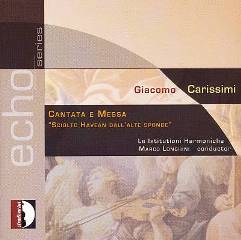Giacomo Carissimi - Cantata e Messa ‘Sciolto Havean Dall'Alte Sponde’ (2012)
Giacomo Carissimi - Cantata e Messa ‘Sciolto Havean Dall'Alte Sponde’ (2012)

01. Messa - Kyrie I 02. Messa - Sinfonia I 03. Messa - Christe 04. Messa - Sinfonia II 05. Messa - Kyrie II 06. Messa - Sinfonia III 07. Messa - Gloria 08. Messa - Officium, Mottetto Suscitavit Dominus 09. Messa - Credo 10. Messa - Offertorium, Mottetto Exurge cor meum 11. Messa - Sanctus 12. Messa - Agnus Dei 13. Messa - Communio, Mottetto Ardens est cor nostrum 14. Messa - Ite, missa est 15. Cantata - Sciolto havean dall'alte sponde 16. Cantata - Eran lingue di tormento 17. Cantata - Amor non più 18. Cantata - Due pupille che son nere 19. Cantata- Non sperar, folle mio core 20. Cantata- Su guancia di rosa 21. Cantata- Amor non più, non più 22. Cantata- Udite, udite, Amanti 23. Cantata- Fosco vel copra le stelle 24. Cantata- Senza sperme di mercede 25. Cantata- Chi d'Amor soffre i martiri 26. Cantata- A miel danni, a ma rovina 27. Cantata- Chi d'Amor soffre i martiri 28. Cantata- Tacquer gl'Amanti a pena 29. Cantata- Amanti, che dite Le Institutioni Harmoniche Marco Longhini - director
The works of Giacomo Carissimi, the giant of the early Italian Baroque outside the realm of opera, are finally receiving recordings beyond his bona fide masterpiece, the oratorio Jephte. The unusual pair of works presented here has also been recorded by the French early music group La Fenice. The Missa Sciolto havean dall'alte sponde is a very late example of the parody mass, a setting of the mass based on music from an existing work, which may be secular and in this case is. The parody mass was a common procedure in the Renaissance, but must have been a novelty in Carissimi's time. The secular work in question is a cantata, Sciolto havean dall'alte sponde, of 1653, depicting a pair of lovers on a storm-tossed sea. The pairing is a fascinating one, offering plenty of insights into how composers of this era thought about representations of the sacred and the secular in music; symbolism travels from cantata to mass, but fundamental changes are made to the material of the cantata, as well, first and foremost its adaptation from a setting for two sopranos, baritone, and continuo to a five-part vocal setting with strings and continuo. The recording here by Le Istituzioni Harmoniche, Verona, under Marco Longhini is bigger in its dimensions, especially in the mass, than that by La Fenice; one imagines this performance being sung in a cathedral (or, in the case of the cantata, in an elaborate garden of a Renaissance palazzo), whereas the La Fenice version evokes a smaller room with a group of musically informed listeners. Another difference is that this disc presents the mass in a sequence of events appropriate to its time, with chant incipits and a few motets by Carissimi (for various forces) inserted into the mass to serve as its Proper sections. (La Fenice uses the extra room to offer an additional work instead.) To an extent the choice between the two is a matter of preference, but for many listeners the intimate atmosphere of the La Fenice disc and the fabulous sensitivity of its singers will better communicate the dramatic touches in Carissimi's settings. ---James Manheim, Rovi
download (mp3 @320 kbs):
uploaded yandex 4shared mega solidfiles zalivalka cloudmailru filecloudio oboom clicknupload
Zmieniony (Środa, 21 Styczeń 2015 16:55)








